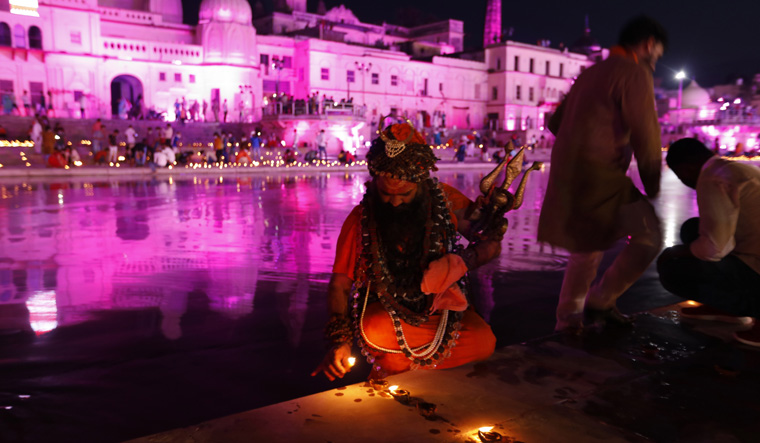With manifold security measures and strict curfews, Ayodhya is all set for the Ram mandir bhoomi pujan that will be attended by 175 people, the most prominent of them being Prime Minister Narendra Modi. The PMO had confirmed his participation on Tuesday, stating that the prime minister will take part in 'pooja' and 'darshan' at Hanumangarhi.
Numerous safety measures are in place. Concerned over the spread of coronavirus, the authorities are encouraging others not to come to the temple town, asking them to mark the occasion by celebrating at their homes. The groundbreaking ceremony will be telecast live. On Tuesday, security checks on vehicles heading to Ayodhya had begun from adjoining Barabanki district on the Lucknow-Ayodhya road. According to reports, policemen have been taking down details, including mobile numbers, of the travellers.
The markets and shops will remain open, but with strict adherence to the coronavirus protocol. Outsiders will be stopped from entering the city, but Ayodhya residents will be allowed in if they produce any identification document. The city's temples and mosques will remain open, but no other religious event except for the bhoomi pujan will take place on Wednesday.
As the event looks set to commence, a look at the history of the movement and how it shaped Hindutva in India.
Historical significance of Ram janmabhoomi
Looking back at history, it is tough to believe that the Ram mandir construction—which most political parties have now embraced, including the opposition Congress leaders—was a contentious issue that Vajpayee had to set aside to form a coalition government.
It was the Vishwa Hindu Parishad (VHP) under late Ashok Singhal which conceptualised the Ram janmbhoomi movement in 1984, and began mobilising sadhus and Hindu groups nationwide. However, the issue gained political currency like never before after the then BJP president L.K. Advani started his 'Ram Rath Yatra' in 1990. This had followed the party's decision to come out openly in support of the temple's construction, where the Babri mosque still stood at that time, in its national executive meeting in Palampur in 1989.
Advani's rath yatra was also seen as a counter to the Mandal politics aimed at reservation for Other Backward Groups (OBCs) unveiled by the V.P. Singh government in 1990. Advani launched the famous procession from Somnath temple in Gujarat on September 25, 1990, drawing people in thousands as his chariot rolled through the country's heartland, at times triggering communal riots as well, while the movement gained momentum. The journey was to end in Ayodhya on October 30, 1990 but was cut short after the then Bihar chief minister Lalu Prasad Yadav ordered Advani's arrest in Samastipur, citing the alleged communal tension it had caused. On the same day, many kar sevaks (religious volunteers) were killed in police firing in Ayodhya as the Mulayam Singh Yadav-led government in Uttar Pradesh used force to stop them from reaching the disputed site. Hindutva groups put the death toll at over 55 even as police said it was 17.
As the Ram temple wave picked up steam, a considerable section of backward castes warmed up to the BJP, which formed its first government in Uttar Pradesh with Kalyan Singh, who hailed from an OBC background, becoming chief minister in 1991. The demolition of Babri Masjid at the disputed site on December 6, 1992 made the party a pariah in politics for a while, but not for long.
Keen to shun the tag of political "untouchable", the BJP under Atal Bihari Vajpayee and Advani was forced to put the issue, considered contentious by most parties, along with Article 370 and the Uniform Civil Code on the backburner to make new allies, a necessity for coming to power in the coalition era between 1989-2014. The party has been steadfast in its commitment to its core causes after Modi took charge of the party and brought it to power in 2014. This was the first time that the BJP won a majority in the 543-member Lok Sabha, making it immune to political pressures that its earlier government under Vajpayee often felt.
The waning of the Hindutva movement due to a variety of reasons coupled with the BJP's organisational atrophy in Uttar Pradesh saw the party steadily losing ground there since late 90s before the 'Modi wave' of 2014 helped it reclaim its bastion in the Lok Sabha polls and then notching up an unprecedented win in the 2017 assembly polls. Now, in its second tenure with massive majority in the Lok Sabha, the BJP looks an unstoppable juggernaut, set to fulfil every single one of its ideological promises.
How Ram mandir movement shaped modern Hindutva leaders like Modi, Yogi
The Ram janmabhoomi movement has played a significant role in shaping the political lives of modern Hindutva stalwarts like Modi and Uttar Pradesh Chief Minister Yogi Adityanath.
As a national office-bearer in the BJP, Modi played an important role in Advani's rath yatra in 1990. It had a polarising effect on the Indian society as it mobilised the majority community which made BJP the major political force in the country today. Modi was in the forefront of running the yatra at that time. In 1991, after the yatra, Modi had suggested that Advani contest from Gandhinagar in Gujarat; he even accompanied Advani when he filed his nomination papers.
Adityanath's late guru Mahant Avaidyanath—also his blood uncle—headed the group of sadhus and Hindu organisations that was formed in 1984 to spearhead the temple movement. The mahant (chief priest) of the Gorakhnath Math was MP from Gorakhpur four times and MLA from Maniram five times. Yogi had come under the influence of the Rashtriya Swayamsevak Sangh while in college and participated in the Ram Janmabhoomi movement. He attended some programmes of Avaidyanath, who, born as Kirpal Bisht, left home after his parents died when he was young.
-Inputs from PTI


